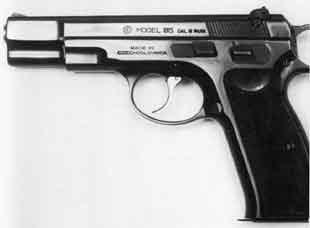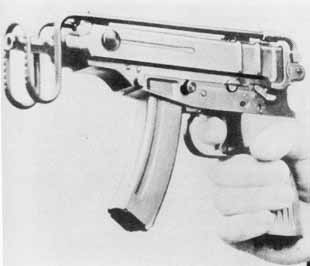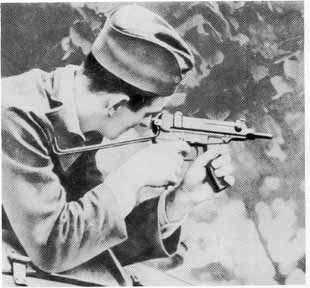VZOR 75 and 85
Nation of origin: Czechoslovakia
Ammunition: 9 x 19 mm
Operation: short recoil
Weight: empty, 1 kg
Length: 203 mm
Length of barrel: 120 mm
Magazine capacity: 15 rounds
Muzzle velocity: approx. 390 m/s

Fig. 5-35: The Czech vzor 85, the updated version of the vzor 75.
Czechoslovakia has long been a large scale producer of weaponry of all kinds, even when the nation was part of the old pre-Great War Austro-Hungarian Empire. During the interwar years, Czech small arms designers devised many innovative weapons .t were to influence numerous other small arms designs that )eared elsewhere, but after 1945 the nation found itself a member of what was to become the Warsaw Pact.
Unlike many of the other states that come under the remit of Soviet Union-dominated Warsaw Pact, the Czech nation has continued to plough its own furrow and produce its own infamous weapon designs. While a degree of weapon commonality with the rest of the Warsaw Pact nations has had to be adopted, the Czechs have been able to retain a certain amount independence and have continued to produce their own options, not only for their own use but for export to many other nations elsewhere. Pistols have been part of their output, but for use prior to 1975, none were produced for export. The Czech forces are still armed with the Czech-designed and pro ed 7.62 mm vzor 52 (vzor means model) or the 7.65 mm vzor both very sound and reliable weapons, but of only limited at ;tion to overseas buyers in the crowded small arms market. The Czechs thus missed out of the pistol export scene to a e degree during the late 1950s and early l960s. This loss was re than offset by export sales of other weapons, but the appearance of an attractive pistol in the Czech arms sales catalogue often felt. In 1975 that was put right by the appearance of the vzor 75.
The vzor 75 has been produced in only one caliber, the widely- : 1 9 mm Parabellum. That alone means that it cannot be ed to the Czech armed forces, for the Warsaw pact does not ize the 9 mm caliber (they use the Soviet 7.62 x 25 mm :arev round, while the Czech armed forces also use a 7.65 mm ol cartridge) so all sales efforts for the vzor 75 had to be made i an eye to exports. The Czechs have been remarkably successful in this difficult field, for the vzor 75 has many sales acivan s, not the least of which is its relatively low price.
The vzor 75 was value-engineered from the start. It had to be F with a price tag that would attract buyers but the relatively price involved could not mean a loss in quality. The opposite proved to be the case, for the vzor 75 is one of the best pistols the Czechs have ever produced. In design terms, it utilizes many of the best points taken from many other pistols, and induces a few good points all of its own.
s it is meant to fire the relatively powerful 9 mm Parabellum ridge, the blowback system was deemed insufficiently reliable, so the short recoil system was used instead. With this system, the barrel remains locked to the slide as it moves backwards after firing for sufficient time to allow the chamber internal pressures to fall to a safe level before the locking system is opened and the slide can move further to the rear for the eject/feed and recocking sequence to commence. The feed system involves a 15-round box magazine with the rounds stacked in a double-row pattern to conserve space and keep the butt dimensions to a manageable level. The safety mechanisms involved mean that an extra round can be carried safely in the chamber, making 16 rounds ready for use if required. The firing pin is kept well back from the cartridge in the chamber until the firing sequence is definitely initiated, and even dropping the pistol onto its muzzle will not result in an unwanted firing. To fire the pistol when a round is already in the chamber, there is no need to pull the slide to the rear. The external hammer is cocked by pulling the trigger for the first shot (once the safety catch has been removed).
The value engineering factor of the vzor 75 is largely achieved by using die castings for the slide and main frame. These are relatively cheap to produce and. require only a minimum of machining before assembly, yet are quite adequate to withstand the stresses imposed upon them. As would be expected, the barrel is high quality steel, as are several other critical components.
Overall, the balance and ‘feel’ of the vzor 75 are first class, and have resulted in many export sales gained in the face of tough op position, most of them made to the police forces of many nations. The customer has the option of walnut or plastic butt grips and can select either fixed sights, or a rear sight with a degree of lateral adjustment. Despite the weight of the weapon it is easy to hold and can deliver fire with accuracy up to the usual combat pistol ranges.
The qualities of the vzor 75 have been carried over to the more recent vzor 85. This is basically the vzor 75 (which remains in full-scale production) with a few enhancements to maintain its position in the market place. Some modifications have been introduced to the internal workings, but they are slight and the biggest change has been made to the manual safety catch and slide stop. On the vzor 75 these are located on the left-hand side of the pistol, but the vzor 85 has been revised to allow them to be fitted on either side and thus make the pistol more attractive butt and at the rear of the square-sectioned receiver. As the breech block is blown to the rear it engages on a spring-loaded hook located at the end of the receiver and is prevented from being pushed back under return spring pressure towards the chamber. At the same time the breech block drives a spring- loaded plunger down into the butt where a system of weights and springs alters its speed of travel so that, as the spring-loaded plunger starts to rise again, it does so at a much slower rate. It is this spring-loaded plunger that releases the breech block from the hook on which it was held and allows the next round to be fed, chambered and fired. The Skorpion does not resemble other automatic pistols in having a slide, for the breech block reciprocates inside the receiver. The weapon is cocked by pulling back a domed cocking button on the left-hand side of the receiver; the button is connected to the breech block.

Fig. 5-40: The Czech Skorpion machine pistol with the wire butt folded.
Note the cured bo magazine and the button on the side of the receiver;
the latter is the cocking device.

Fig. 5-41: The Skorpion in its intended combat mode being used from
an armored vehicle.
The fire rate reduction device in the butt means that the magazine has to be located in front of the trigger guard. The magazine is slightly curved and may hold 10 or 20 rounds, with the operational emphasis being placed on the 20-round magazine; when firing on automatic it does not take long to fire off all available rounds. Needless to day, the barrel movement when firing bursts is still lively, and firing the pistol on automatic with one hand is not recommended when accuracy is required, no matter how impressive it may appear visually. To enable more control, the Skorpion is fitted with a rudimentary wire butt that folds up and over the receiver in a neat fashion when the pistol is stowed in its holster. Firing the Skorpion one-handed on single shot is stated to be easy and accurate. One small point must be remembered when firing the Skorpion: the ejector slot is on top of the receiver, so that if the weapon is fired from around waist level and close to the body, it is possible for ejected cases to hit the firer in the face.
The Skorpion was issued to the Czech armed forces and has been widely exported, especially to Africa where the weapon is much favored by the personal bodyguards of heads of state and other senior officials. In order to make the weapon more attractive to potential buyers, the Skorpion was produced in several calibers. The first was the vzor 63, which fires the American 0.38 Auto round. Then came the vzor 64 firing the 9 x 18 mm
Makarov cartridge, now widely used by Warsaw Pact and Soviet-influenced nations. Finally there was the vzor 68 which fires the ubiquitous 9 x 19 mm Parabellum round. All Czech versions of the Skorpion are now out of production, but a license-produced 7.65 mm version is still produced in Yugoslavia for issue to the Yugoslav armed forces and for possible export sales; it is known Despite its odd hybrid nature, for by being a machine pistol as the Model 61(j).
The weapon is neither a good pistol nor a good sub-machine gun, the Skorpion may be widely encountered. It is still in front-line service with the Czech armed forces and, as has been mentioned, may be found in use with nations such as Ghana, Mozambique, Uganda and Angola. However, the main impact of the Skorpion these days is likely to be in the hands of various forms of ‘freedom fighter’ who have discovered that the Skorpion is a remarkably effective weapon at short ranges and in enclosed areas. Skorpions have been noted during television newsreel coverage of the fighting in Lebanon.
It was no doubt with terrorist/freedom fighter employment in mind that a silenced (Or moderated) version of the Skorpion was developed. With this version there was no pretence at a highly efficient or special silencer system, for the Skorpion silencer is simply a long tube containing a number of rubber baffles and a muzzle plug through which the bullet has to travel after leaving the muzzle. The silencer tube screws on to a thread incised into a special barrel extension, while the baffles simply damp down the sound of a cartridge firing. No attempt is made to reduce the sound of breech block movement. It would appear that the silenced model was intended for single-shot use only. When in position, the silencer prevents the wire butt folding down over the muzzle. The silenced version of the Skorpion is rarely seen, and not many appear to have been produced.

Fig. 5-42: A Skorpion fitted with a silencer (moderator) and with the
wire butt extended.